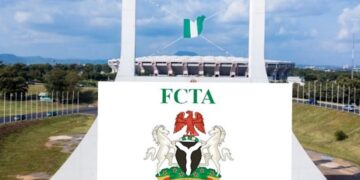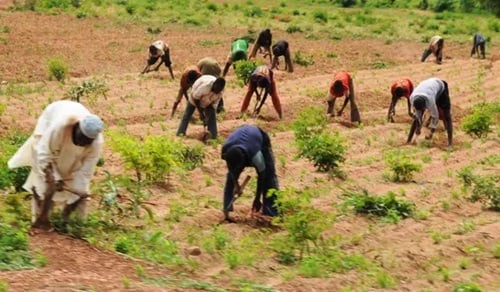Nigeria prepares for the new farming season as the 2025 rainfall forecast indicates significant regional variations, with coastal states facing potential flooding while northern regions confront drought conditions.
This is according to the 2025 Season Climate Prediction by the Nigerian Meteorological Agency (NiMet) released recently, revealing stark regional variations in rainfall patterns that could significantly impact agriculture across the country.
Coastal states including Bayelsa, Rivers, and Akwa Ibom will experience an early onset of rains between February 23 and March 10, with the wet season lasting up to 290 days and bringing heavy precipitation of 2,700-3,010mm. This raises serious flood concerns for these vulnerable regions.
In contrast, northern states like Sokoto, Katsina, and Borno face delayed rainfall beginning only in June or July, with the season ending as early as October.
These areas will receive less than 685mm of rain annually, potentially triggering drought conditions. The central belt, including key agricultural states like Benue and Plateau, will see moderate rainfall between April-May and November, but farmers must contend with a compressed 150-200 day growing window.
These disparities present major challenges for Nigeria’s largely rain-fed agricultural sector. Southern farmers must implement flood mitigation measures, while their northern counterparts may require emergency irrigation solutions to prevent crop failures. The shortened planting season in central Nigeria could disrupt food production in the nation’s breadbasket region.
NiMet advises all stakeholders to use this forecast for proactive planning, emphasizing that climate-adaptive farming techniques will be crucial for food security in the coming year. The agency warns that failure to prepare could lead to reduced harvests, higher food prices, and increased vulnerability to climate shocks across the country.
Which Way to Go?
Nigeria faces a significant and escalating crisis of hunger and poverty, driven by a combination of economic challenges, conflict, climate change, and inadequate agricultural production. As of 2025, it is projected that 33.1 million Nigerians will experience acute food insecurity, a stark increase from 25 million in previous assessments.
This represents an alarming rise of 7 million people from the previous year due to factors such as economic hardship and climate shocks. Approximately 5.4 million children and 800,000 pregnant and breastfeeding women are at risk of acute malnutrition. Of these, about 1.8 million children could face Severe Acute Malnutrition (SAM), requiring urgent nutritional intervention.
But, what substantive interventions has the government implemented to establish viable alternatives for enhancing domestic food production? The 2025 agricultural budget allocation has drawn considerable criticism from sectoral stakeholders.
The proposed funding allocation proves inadequate when contextualised against the nation’s escalating food security crisis, exacerbated by rampant inflationary pressures.
Poor Budgetary Allocation
Nigeria’s 2025 federal budget, presented on December 18, 2024, allocates a meager 1.28% (₦636.08 billion) to the agricultural sector despite escalating food insecurity and inflationary pressures. This allocation marks a significant 36% reduction from 2024’s N996.9 billion agricultural budget and falls woefully short of the 10% target prescribed by the Maputo Declaration.
The sector’s declining funding trajectory – from N626.99 billion in 2023 to N462.19 billion in 2022 – raises serious concerns about the government’s commitment to addressing the nation’s food crisis, experts have argued.
When adjusted for Nigeria’s current 34.6% inflation rate (though debased to 25% recently), the real value of the 2025 agricultural budget diminishes to approximantly N616.99 billion, representing a N19.1 billion loss in purchasing power. This underfunding persists despite President Tinubu’s ambitious economic targets to halve inflation to 15% and strengthen the naira to N1,500 per US dollar by 2025.
The inadequate budgetary provision appears particularly troubling given the compounding challenges of climate variability, rising input costs, and persistent insecurity in farming communities. With food inflation hovering around 30- 28% and millions facing hunger, agricultural stakeholders question how such limited funding can possibly stimulate the necessary productivity gains to achieve food security.
The budget’s disproportionate focus on debt servicing (33%) and recurrent expenditure (28%) further highlights the misplaced priorities in national spending, leaving Nigeria’s crucial agricultural sector dangerously undercapitalized at a time when strategic investment is most urgently needed.
President Bola Ahmed Tinubu has pledged to lower the cost of food and essential drugs in 2025, citing these as significant concerns for many Nigerian households in 2024.
To achieve this, the government plans to boost food production and promote local manufacturing of essential drugs and other medical supplies.
In his New Year’s message, President Tinubu noted that despite the stock market’s record growth and increased foreign investment, the cost of food and essential drugs remains a challenge.
“In 2025, our government is committed to intensifying efforts to lower these costs… We are resolute in our ambition to reduce inflation from its current high of 34.6% to 15%,” he said.
The Federal Government has therefore, announced a comprehensive strategy to combat Nigeria’s worsening food insecurity and stabilise escalating food prices in the coming year. Abubakar Kyari, Minister of Agriculture and Food Security, detailed these measures during a recent press briefing in Abuja, emphasising the administration’s commitment to enhancing agricultural productivity beyond conventional budget allocations.
Expansion of Wheat Cultivation
Building on the success of dry-season wheat farming, the government will introduce wet-season wheat cultivation in highland states with suitable climates, including Cross River, Plateau, and Taraba. This pioneering initiative marks the first inclusion of southern states in Nigeria’s wheat production programme. Under the completed first phase of dry-season farming, 300,000 farmers cultivated 150,000 hectares with government-subsidised seeds (25% farmer contribution) and fertilisers (50% subsidy).
Modernisation Through Mechanisation
The first shipment of 2,000 tractors from Belarus has begun arriving at Lagos ports, representing a significant step towards President Tinubu’s mechanisation agenda. These agricultural implements will be distributed nationwide to reduce reliance on traditional farming methods, which the minister described as outdated and deterring new entrants to the profession.
Revitalisation of Agricultural Financing
Plans are underway to recapitalise the Bank of Agriculture, with its 109 senatorial district branches positioned to provide enhanced financial support to smallholder farmers. The ministry is collaborating with international partners, including the International Fund for Agricultural Development (IFAD), to expand funding opportunities, with concrete restructuring plans expected in Q1 2025.
Reduction of Post-Harvest Losses
The government is developing strategies to address Nigeria’s staggering N3.5 trillion annual post-harvest losses, prioritising improved storage infrastructure as a key component of food security measures.
Regional Specialisation in Crop Production
The administration will focus on expanding tomato cultivation in the South-East and South-West, with harvests anticipated by May 2025. This forms part of broader efforts to optimise regional agricultural potential.
Minister Kyari stressed that these interventions complement the National Agricultural Growth Support Scheme-Agro Pocket Project, which assisted 400,000 wheat and rice farmers during the 2024/2025 dry season. The multi-pronged approach aims to transform Nigeria’s agricultural sector while addressing immediate food security concerns.











































Discussion about this post